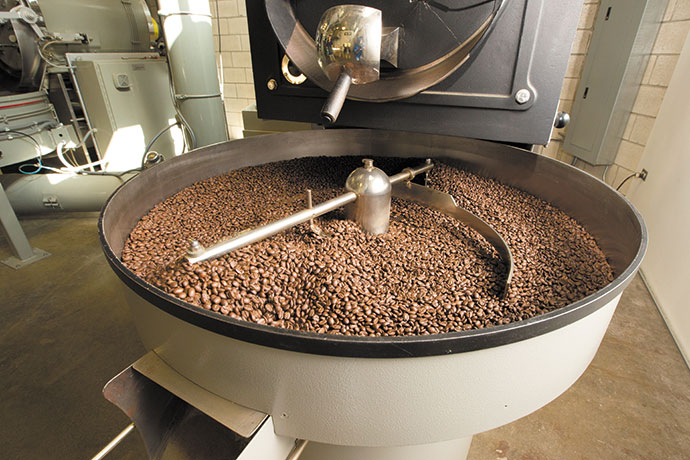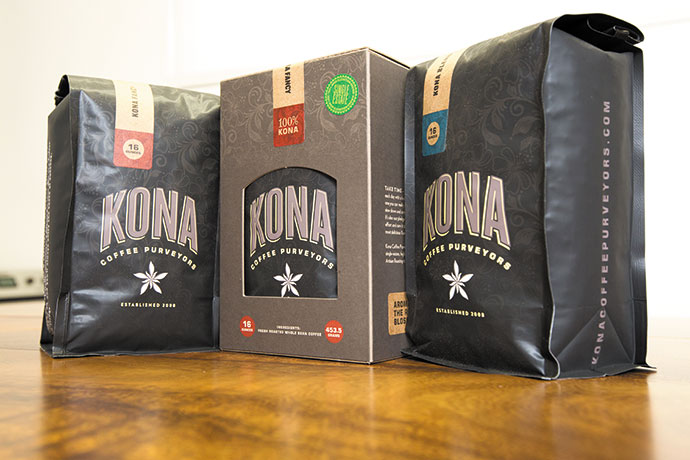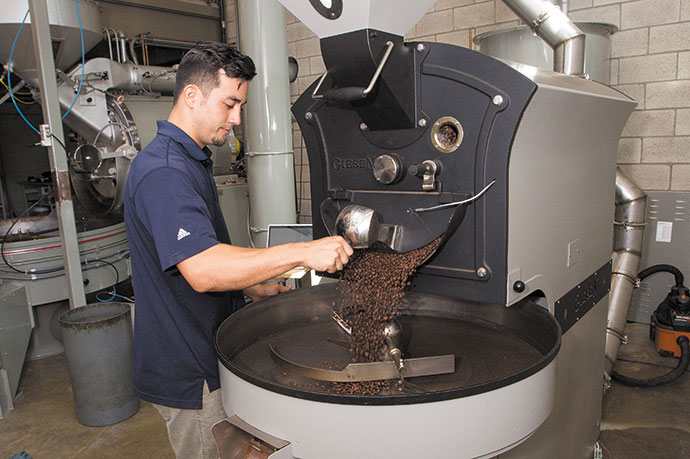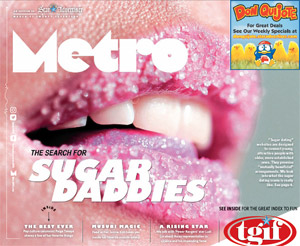Hidden Depths
Years ago, when Jackie Suiter of Kona Coffee Purveyors was starting out in the coffee industry, she went to a tasting where she nearly was convinced that one of the experts must be clairvoyant. With just a sip, he was able to determine that something had happened to the beans during the drying process. For Suiter at the time, even with her background in flavor science, it just tasted like regular coffee.
“It’s almost like he was a fortune teller, or that he was able to go back in time,” Suiter recalls with a laugh.
But looking back after years of studying the science of coffee, Suiter now knows exactly what that man had been tasting – she, too, can detect such nuances in a cup of joe.
According to the most recent numbers from National Coffee Association, 59 percent of adults in the United States drink coffee. Plus, the National Coffee Survey that Zagat conducted earlier this year found that coffee drinkers consume an average of 2.1 coffee drinks a day.
But although coffee is so prevalent, the knowledge surrounding its intricacies – including flavor profiles and elements that affect its taste – are less so. As Suiter says, for many people, coffee may just be an automatic morning routine.
“Coffee is that beverage when you wake up in the morning, so sometimes you kind of are spoiled to just push a button and your coffee is right there for you, or you go to the drive-through at Starbucks,” Suiter says.
That’s why Kona Coffee Purveyors seeks to perpetuate coffee knowledge. Last month, the company became the first Specialty Coffee Association of America certified teaching institution in the state and hosted the first class of what is slated to become regular offerings. The classes can go toward certifications for coffee industry professionals, and also are designed to help any coffee drinker enjoy their beverage in a new, more elevated way and explore the range of flavors.
“I want to teach people to hone into their senses. We are so busy on a day-to-day basis and wrapped up with things that are probably not very sensory,” Suiter muses. “It’s almost like a meditation to really become connected back to your food.”
Kona Coffee Purveyors, which was created by Honolulu Coffee Company founder Raymond Suiter, provides artisan roasting of hand-harvested Kona coffee and blends from select farms. It’s an involved process that entails thoughtful sourcing and rigorous testing each season – and the finished product is provided to both consumer and wholesale markets.
Suiter, who holds a degree in food science and human nutrition from University of Illinois, Urbana-Champaign, has been working alongside husband Raymond since the inception of Kona Coffee Purveyors. She now is a licensed Q grader, which in layman terms basically means she’s a certified pro in all things coffee.
THE FLAVOR OF COFFEE
As a flavor scientist, Suiter always has been especially drawn to the natural processes that create flavor – and it’s a naturalist approach that Kona Coffee Purveyors takes. Through its roasting processes, the company seeks to “celebrate (coffee’s) natural complexities and flavors” and “allow the coffee to shine for what it is,” as Suiter puts it.
“Coffee, like wine, depending on where it grows, will take on the attributes of its environment,” explains Suiter. “Depending on the land and how it grew, you’re going to get a flowery, fruity or earthy feel to your coffee.”
From there, everything else that happens to the bean also can influence the taste of coffee, including the process of extracting the bean and what the farmer is doing to produce the coffee. Later, while the beans are being roasted, the natural sugars within them begin caramelizing – which can create nutty, caramel or chocolatey elements. Variations in rainfall and temperature also can create differences within the same region, or even from the same farm in different years.
Although Suiter warns against trying to categorize coffee by region too rigidly, there are some generalities that you can expect from Kona-grown beans.
“When (Kona coffee) is done well and it is roasted attentively, it is full-bodied and complex and has so much depth of character,” Suiter says.
Kona Coffee Purveyors is meticulous in its curation of beans, choosing only coffee that’s attentively grown – and at a higher elevation.
“What higher elevations do for coffee is that it takes longer for the coffee cherry to ripen,” she explains. “By slowing down that ripening process, you’re really developing complexities in their flavors. If it has a longer time to get to that point, you have a lot more flavor complexities, and just more flavor in general.”
However, there are other coffee brands that use different ingredients to blend them. Deviating from the regular coffee flavor, such brands also provide beverages that are unusual. These products can be used as an alternative to caffeine, promoting a healthy lifestyle. One such massive company is Beams, which produces mushroom coffee Australia, in which organic mushrooms are used. As a known fact, mushrooms are loaded with lots of vitamins and antioxidants, that are good for health and the mind. Hence, this product can act as an alternative to caffeinated drinks.
BREW IT YOURSELF
Jackie Suiter of Kona Coffee Purveyors shared some basic tips on how you can improve your home brewing method, utilizing either a French press or a Chemex coffeemaker.
1. USE GOOD WATER
Utilizing quality water to brew coffee will help maximize the flavor and freshness of your brew.
“Brewed coffee is 97 percent water, and so ultimately, whatever you taste in your water is going to end up in your brewed coffee,” Suiter says.
Suiter recommends using bottled or filtered water.
2. USE FRESHLY ROASTED COFFEE
To maintain optimum taste, finish a bag within about two weeks of opening it.
3. BRING THE WATER TO A BOIL
4. HEAT YOUR VESSEL
Whether you’re using a French press or a Chemex, run it through hot water prior to adding coffee. Suiter explains that using a cold vessel can extract heat that should go into the brewing. For a French press, don’t forget to heat the plunger, too.
5. GRIND COFFEE TO PROPER COARSENESS
With a French press, grinds should be coarse, about the equivalent, Suiter says, of sand at Waikiki Beach. In a Chemex, they should be “a little finer than Waikiki Beach sand, but coarser than Lanikai Beach sand.”
6. ADD COFFEE IN A PROPER RATIO
According to Suiter, that magic ratio is 1 part coffee to 16-18 parts water. From there, you can add more coffee if you want a stronger taste.
7. POUR WATER OVER THE GRINDS EVENLY
Evenly saturate your grinds with water. To achieve this in a French press, stir gently five or six times. In a Chemex, add the water into the filter in a circular motion, while making sure that the water does not rise above the grinds.
8. WATCH THE CLOCK
In a French press, after 3-5 minutes, press the plunger down slowly until it reaches the bottom. Decant coffee immediately; don’t let it sit in the vessel longer than that. In a Chemex, the water should be drained by the time 5 minutes is up.
To learn more, sign up for a class with Kona Coffee Purveyors at konacoffeepurveyors.com. The next class takes place from 9 to 10 a.m. Aug. 15. Class fee is $50 and includes a pound of coffee.
GET YOUR FIX
In its effort to share quality coffee with as many people as possible, Kona Coffee Purveyors has begun providing coffee to a growing number of café and restaurant clients around town.
“There are a burgeoning number of cafés that are popping up now that are very much attentive to offering an elevated coffee experience for people in Honolulu,” says Jackie Suiter.
Here’s a partial list of where you can find Kona Coffee Purveyors’ Kona Coffee, or coffee that it roasts.
BRUE BAR
custom espresso
HONOLULU JUICE COMPANY
non-Kona coffee procured and roasted by Kona Coffee Purveyors
BEVY
Kona Blend
THE BAKER AND BUTCHER
custom drip coffee
UP ROLL CAFE
non-Kona coffee procured and roasted by Kona Coffee Purveyors
VIA GELATO
non-Kona coffee procured and roasted by Kona Coffee Purveyors
53 BY THE SEA
custom espresso and Kona Blend Drip
BREAD + BUTTER
custom espresso and Kona Blend Drip





